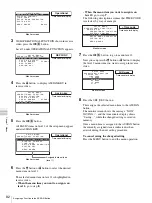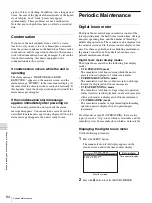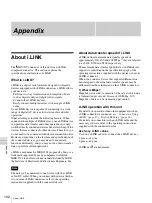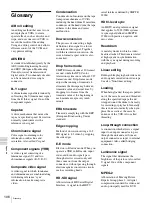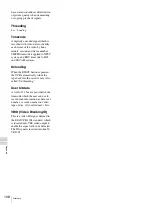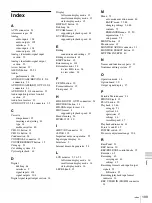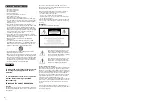
106
Glossary
Ap
pend
ix
Glossary
A/B roll editing
An editing method that uses two or
more playback VCRs to create
special effects such as dissolve and
wipe, and uses one record VCR to
record the results of the editing.
Using an editing control unit allows
efficient control of the VCRs and
very precise editing.
AES/EBU
A standard established jointly by the
AES (Audio Engineering Society)
and EBU (European Broadcasting
Union) for serial transmission of
digital audio. Two channels of audio
can be transmitted via a single
connector.
B–Y signal
A chrominance signal determined by
subtracting the Y (luminance) signal
from the B (blue) signal. One of the
component signals.
Capstan
A drive mechanism that moves the
tape at a specified speed. Its rotation
normally synchronizes with a
reference sync signal.
Chrominance signal
Color signal containing color
information such as hue and
saturation. Also called C signal.
Component signals (YRB)
A video signal consisting of a
luminance signal (Y) and two
chrominance signals (R–Y, B–Y).
Composite video signal
A video signal in which luminance
and chrominance are combined along
with timing reference “sync”
information to make composite
video.
Condensation
Condensation of moisture on the tape
transport mechanisms of VCRs
including the head drum. If moisture
condenses on the head drum, the tape
adheres to the drum and causes
malfunction.
Down-conversion
The process of converting a high-
definition video signal to a lower
resolution video signal. Together
with the resolution conversion, the
screen format (aspect ratio) is also
converted.
Drop frame mode
SMPTE timecode runs at 30 frames/
second, while the NTSC color
television system runs at about 29.97
frames/second. Drop-frame mode
adjusts the running of timecode to
eliminate the discrepancy between
timecode value and actual time by
dropping two frames from the
timecode value at the beginning of
each minute except every tenth
minute.
EBU timecode
Timecode complying with the EBU
(European Broadcasting Union)
standard.
Edge cropping
Method of down-converting a 16:9
HD signal to 4:3 video by cropping
the side edges.
E-E mode
Electric-to-Electric mode. When you
operate a VDR in E-E mode, input
video and/or audio signals pass
through electric circuits only and
then come out from the output
connectors, without passing through
electromagnetic conversion circuits
such as recording heads.
HD-SDI signal
Abbreviation of HD Serial Digital
Interface. A signal in the HDTV
serial interface defined by SMPTE
292M.
HD tri-level sync
An HDTV analog reference signal
that applies to 59.94/50Hz systems.
A sync signal defined in SMPTE
274M with positive, negative, and
zero values.
Head drum
A metal cylinder to which a video
head is attached. This drum is rotated
at high speeds in synchronization
with the sync signal during recording
and playback.
Linear editing
Editing while playing back video and
audio signals recorded on video tape.
See also “Non-linear editing.”
Loading
When being loaded, the tape is pulled
out of the cassette case and threaded
along the specified tape path and
wrapped round the drum to be ready
for recording or playback. Generally,
this is done automatically when you
place the cassette at the cassette
entrance of the VCR. Also called
threading.
Loop-through connection
A connection which allows a signal
input to an input connector to pass
through the unit and exit from an
output connector as input to external
equipment. Also called bridging
connection.
Luminance signal
The signal that determines the
brightness of the picture. Also called
Y signal. One of the component
signals.
MPEG-2
Abbreviation of Moving Picture
Experts Group phase 2. A digital
compression standard for video and
audio, principally used for DVD

